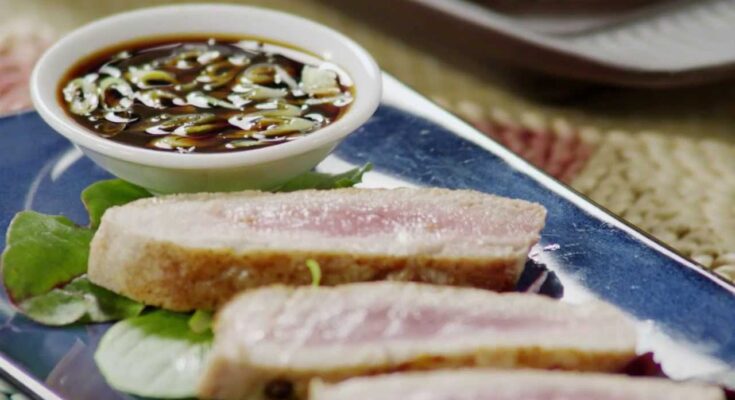Grilled Tuna Steak Recipe: There’s something truly special about a perfectly grilled tuna steak. Unlike other types of fish, tuna has a meaty, steak-like texture that makes it ideal for grilling. It’s firm, flavorful, and versatile enough to pair with a wide variety of marinades and sides. If you’ve ever wanted to bring restaurant-quality seafood to your own kitchen, then learning how to prepare grilled tuna steak is a must.
One of the main reasons tuna steaks are loved by home cooks and chefs alike is their ability to absorb flavors quickly without losing their natural taste. Whether you want a citrusy, refreshing marinade or a bold and spicy one, tuna adapts beautifully. Unlike salmon or cod, which tend to flake easily, tuna maintains its shape, making it beginner-friendly for those who are new to grilling fish.
Another great advantage of tuna steaks is their nutritional value. They are packed with protein and omega-3 fatty acids, which are known for boosting heart health, supporting brain function, and reducing inflammation. For those who want a lean, satisfying meal without sacrificing flavor, grilled tuna steaks check all the boxes.
So, if you’re ready to take your grilling game to the next level, this step-by-step guide will walk you through everything: the ingredients, preparation, cooking process, and even some tips to make your tuna steak turn out better than any restaurant’s.
Ingredients You’ll Need for Grilled Tuna Steak
Cooking a delicious tuna steak starts with having the right ingredients on hand. The good news is, you don’t need a long list of complicated items. A few fresh ingredients, combined with some everyday seasonings, are enough to create a flavorful and juicy tuna steak that impresses every time.
Fresh Tuna Steaks (Selecting the Best Cut)
When buying tuna steaks, freshness is the key. Look for steaks that are about 1 to 1.5 inches thick, with a firm texture and vibrant pink-to-red color. Avoid tuna that looks dull, brownish, or has an overly fishy smell—it’s a sign that it isn’t fresh. Yellowfin (Ahi) and Bluefin are the most popular choices for grilling because of their texture and flavor.
Marinade Essentials (Olive Oil, Soy Sauce, Lemon Juice, etc.)
A simple marinade enhances tuna without overpowering its natural taste. A good base includes:
- Olive oil – adds richness and prevents sticking on the grill
- Soy sauce – gives a salty, umami punch
- Lemon or lime juice – balances the flavors with acidity
- Garlic – for depth of flavor
Herbs and Seasonings for Flavor
To elevate the dish, fresh herbs like rosemary, thyme, or parsley work beautifully. You can also add ground black pepper, sea salt, and chili flakes if you want a touch of spice.
Optional Ingredients for Extra Taste
For those who love bold flavors, consider adding:
- Ginger for an Asian twist
- Balsamic vinegar for sweetness
- Sesame oil for a nutty aroma
- Paprika or Cajun spices for heat
These simple additions allow you to customize the flavor of your grilled tuna steak depending on your mood or the theme of your meal.
Kitchen Tools and Equipment You’ll Need
Before you start cooking, make sure you have the right tools. Tuna steaks cook very quickly, so having everything ready beforehand ensures smooth preparation.
Grill Options (Gas, Charcoal, Indoor Grill Pan)
- Gas Grill: Provides even heating and is easy to control. Perfect for beginners.
- Charcoal Grill: Adds a smoky flavor that pairs wonderfully with tuna but requires more attention.
- Indoor Grill Pan: Ideal if you don’t have outdoor space. Cast-iron pans work best for achieving those beautiful grill marks.
Basic Utensils for Easy Preparation
- Tongs or a spatula for flipping
- A mixing bowl for the marinade
- A brush for applying oil
- Meat thermometer to check internal temperature
Having these tools ready makes the grilling process easier and prevents overcooking—a common mistake with tuna.
Step-by-Step Guide to Making Grilled Tuna Steaks
This is where the magic happens. Grilling tuna isn’t complicated, but following each step carefully makes the difference between a dry, overcooked piece of fish and a juicy, flavorful steak.
Step 1 – Preparing the Tuna Steaks
Pat the tuna steaks dry with paper towels. This step is crucial because excess moisture prevents the marinade from sticking properly and can cause steaming instead of searing on the grill.
Step 2 – Making the Marinade
In a bowl, whisk together olive oil, soy sauce, lemon juice, minced garlic, and any additional seasonings you like. Taste the marinade before applying—it should be balanced between salty, tangy, and savory.
Step 3 – Marinating the Tuna Steaks
Place the tuna steaks in a shallow dish or resealable bag and pour the marinade over them. Let them sit for at least 20–30 minutes, but not longer than 1 hour, as the acidity from lemon juice can start to “cook” the fish.
Step 4 – Preheating and Preparing the Grill
Heat your grill (or grill pan) on medium-high. Lightly oil the grates to prevent sticking. A hot grill is essential for locking in the juices and achieving that perfect sear.
Step 5 – Grilling the Tuna Steaks to Perfection
Place the steaks on the grill and cook for about 2–3 minutes per side for medium-rare. Tuna is best enjoyed slightly pink in the center. If you prefer well-done, leave it longer, but be careful—overcooking makes tuna dry.
Step 6 – Resting and Serving
Remove the tuna steaks from the grill and let them rest for 2–3 minutes before slicing. This allows the juices to redistribute, keeping the steak moist and flavorful. Serve with fresh lemon wedges and garnish with herbs.
Tips for Perfectly Grilled Tuna Steaks
Grilling tuna is all about balance. While it’s tempting to cook it longer, tuna is one of those proteins that tastes best when slightly underdone in the center.
How to Avoid Overcooking Tuna
Keep an eye on the clock. Tuna steaks cook incredibly fast. If you’re unsure, it’s always better to slightly undercook than overcook—you can always put it back on the grill for another minute.
Best Internal Temperature for Tuna Steaks
For medium-rare, aim for an internal temperature of 125°F (52°C). If you prefer medium, go up to 135°F (57°C). Anything beyond that risks making it dry.
Flavor Pairing Suggestions
- Pair with a squeeze of lemon or lime for freshness.
- Serve with wasabi or soy-based dipping sauce for an Asian touch.
- Add a drizzle of garlic butter for richness.
These tips ensure your grilled tuna steak is juicy, flavorful, and restaurant-worthy.
Side Dishes to Serve with Grilled Tuna Steak
A great tuna steak deserves equally amazing sides. The right pairings not only enhance the flavors of your grilled tuna but also balance the meal nutritionally. Since tuna is rich and meaty, lighter and fresher accompaniments usually work best.
Fresh Salads
Salads are a natural partner for tuna steaks. A crisp green salad with lettuce, cucumbers, cherry tomatoes, and a zesty vinaigrette makes a refreshing contrast to the richness of tuna. You can also try a Mediterranean-inspired salad with olives, feta cheese, red onions, and oregano for a bold and flavorful side. For something more filling, a chickpea or quinoa salad with herbs and lemon dressing works beautifully.
Grilled Vegetables
Why not make the most of your grill? Grilled zucchini, bell peppers, asparagus, and eggplant add smoky flavors that complement the seared tuna perfectly. Drizzle them with olive oil and sprinkle with sea salt before grilling. For added flavor, a dash of balsamic glaze ties everything together.
Rice, Quinoa, or Couscous
Grain-based sides balance the meal and add texture. A bed of fluffy jasmine rice or wild rice gives a comforting base for your tuna steak. Quinoa is an excellent high-protein option if you’re keeping things light. Couscous with herbs, lemon zest, and roasted vegetables can also elevate the entire dish with minimal effort.
The key is balance—if your tuna is heavily seasoned, go with lighter sides. If your tuna is simply grilled with basic seasoning, you can afford to add a bolder, more flavorful side dish.
Common Mistakes to Avoid When Grilling Tuna
Even though grilling tuna is fairly simple, a few common mistakes can ruin the outcome. Let’s go over what not to do so you can avoid them and enjoy a flawless tuna steak every time.
Over-Marinating the Tuna
Unlike chicken or beef, tuna doesn’t need hours of marinating. In fact, leaving it in acidic marinades for too long can “cook” the fish before it even hits the grill, making it mushy. Stick to 20–30 minutes for the perfect balance.
Using Too Much Heat
While you want your grill hot enough to sear, extremely high heat can burn the outside before the inside is properly cooked. Medium-high heat is usually the sweet spot for tuna steaks. If you’re using a charcoal grill, make sure the flames have settled into glowing embers before placing the fish on top.
Flipping Too Often
Tuna steaks need only one flip. Constantly flipping prevents a good sear from forming and can cause the fish to stick to the grill. Let it cook undisturbed on one side before turning it over once.
Cooking Without Oil
Tuna is lean and can stick to the grill if not properly oiled. Always brush both the grill grates and the tuna steak lightly with oil before grilling.
Avoiding these mistakes ensures your tuna steak stays tender, juicy, and beautifully grilled.
Storage and Reheating Tips
Sometimes you might have leftovers, and the last thing you want is for your tuna steak to turn dry or lose flavor. Proper storage and reheating can make all the difference.
How to Store Leftover Tuna Steaks
- Allow the tuna to cool completely before storing.
- Wrap tightly in foil or place in an airtight container.
- Store in the refrigerator for up to 2 days.
- For longer storage, you can freeze tuna steaks for up to 2 months, but keep in mind that the texture may slightly change after thawing.
Best Ways to Reheat Without Losing Flavor
Reheating tuna can be tricky because it’s easy to overcook. Here are the best options:
- Stovetop: Heat a non-stick pan with a drizzle of olive oil and warm the tuna on low heat for just a couple of minutes.
- Oven: Wrap in foil and warm in a preheated oven at 275°F (135°C) for 10–12 minutes.
- Microwave (not recommended): If you must use a microwave, reheat in short 20-second bursts, checking after each interval.
Another option? Don’t reheat at all! Cold tuna steak works wonderfully in salads or sandwiches the next day.
Variations of Grilled Tuna Steak
The beauty of tuna steak is how adaptable it is. With a few tweaks to your marinade and sides, you can take this dish in countless directions.
Asian-Style Tuna Steak
For an Asian-inspired version, use soy sauce, sesame oil, fresh ginger, garlic, and a touch of honey in your marinade. Sprinkle with sesame seeds before serving and pair with steamed rice and stir-fried veggies.
Mediterranean-Style Tuna Steak
Mediterranean flavors bring out the freshness of tuna beautifully. Marinate with olive oil, lemon juice, oregano, garlic, and rosemary. Serve alongside couscous, olives, and a Greek salad for a complete meal.
Spicy Cajun Tuna Steak
If you like bold flavors, coat your tuna steaks with a Cajun spice rub made of paprika, cayenne pepper, garlic powder, onion powder, and thyme. Grill as usual and serve with grilled corn or roasted potatoes.
These variations allow you to reinvent the same dish over and over, keeping it exciting every time you grill tuna.
Nutritional Value of Tuna Steaks
Tuna steaks aren’t just delicious—they’re also incredibly nutritious, making them a smart choice for health-conscious eaters.
Calories and Macronutrients
A typical 6-ounce tuna steak contains:
- Calories: Around 200
- Protein: About 40 grams
- Fat: 2–3 grams (very lean compared to other proteins)
- Carbohydrates: 0 grams
This makes tuna steak an excellent option for low-carb, keto, and high-protein diets.
Omega-3 Fatty Acids and Protein Content
Tuna is packed with omega-3 fatty acids, which help reduce inflammation, support brain health, and improve cardiovascular function. It’s also a fantastic source of lean protein, making it ideal for athletes, fitness enthusiasts, or anyone looking to maintain muscle while eating clean.
In short, grilled tuna steak isn’t just a treat for your taste buds—it’s also a powerhouse of nutrition.
FAQs about Grilled Tuna Steak Recipe
Q1: Can I cook tuna steak well-done?
Yes, but it’s not recommended. Tuna tastes best when slightly pink in the center, as overcooking makes it dry and tough.
Q2: How long should I marinate tuna steaks?
20–30 minutes is enough. Longer than 1 hour may cause the fish to become mushy.
Q3: Do I need to use fresh tuna, or can I use frozen?
Frozen tuna works fine if it’s good quality. Just make sure to thaw it properly in the fridge before marinating.
Q4: What wine pairs best with grilled tuna?
Crisp white wines like Sauvignon Blanc or light reds like Pinot Noir pair wonderfully with tuna steak.
Q5: Is tuna steak safe to eat rare?
Yes, as long as it’s sushi-grade tuna from a trusted source. Many people prefer it rare or medium-rare for the best flavor and texture.
Conclusion
Grilling tuna steak at home doesn’t have to be intimidating. With the right ingredients, a good marinade, and careful cooking, you can prepare a meal that rivals any fine-dining restaurant. From selecting the best cut of tuna to mastering the perfect grill time, every step matters. Add in some refreshing sides, experiment with flavor variations, and you’ll have a versatile dish that fits any occasion—whether it’s a weeknight dinner or a special gathering.
Tuna steak isn’t just food; it’s an experience—juicy, flavorful, and nutritious all at once. Now it’s your turn to fire up the grill and make it happen.



